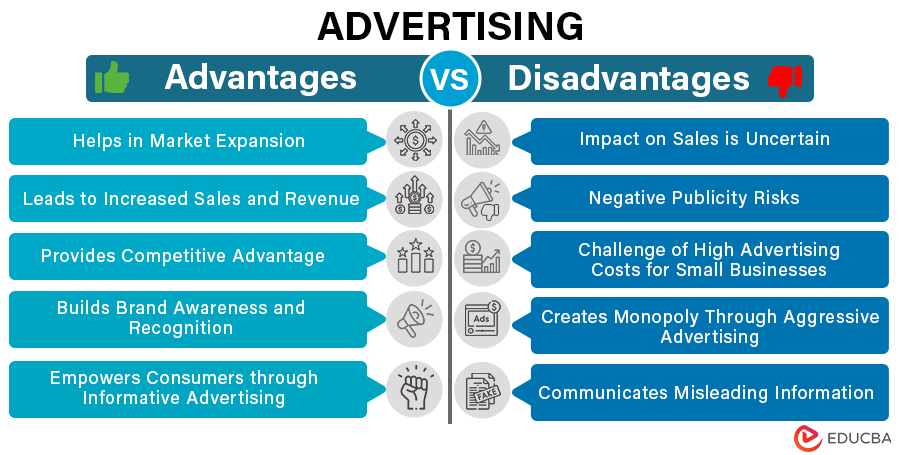Advantages and Disadvantages of Advertising – Introduction
Advertising is a marketing strategy that aims to promote a specific product, cause, or service. The term “advertising” comes from the Latin word “adventure,” which means to turn someone’s attention towards something. While large corporations often invest heavily in traditional ad campaigns, many small businesses are now turning to affordable social media management solutions to reach their target audiences effectively. A business, company, or organization tries to reach a large audience through advertising – whether through print media, digital campaigns, or social platforms. Though advertisement has its advantages, it also has its disadvantages. This article aims to cover both sides of advertising.

Advantages of Advertising
With advertising, a business or an organization needs a new product. It is the best method for communicating any information to old and new prospective customers. Here are the advantages of advertising:
1. Helps in Market Expansion
Through advertising, businesses can reach new markets and demographics, expanding their customer base. This is especially true when you diversify your advertising channels and expand into all types of mediums such as social media, email using email software like ActiveCampaign or ClickFunnels, and even SMS via an SMS broadcast app.
2. Leads to Increased Sales and Revenue
One of the primary goals of advertising is to drive sales and boost revenue for businesses. Effective advertising campaigns can create awareness and generate interest, increasing sales.
3. Provides Competitive Advantage
Effective advertising can differentiate a product or service from competitors, giving a company a competitive edge.
4. Builds Brand Awareness and Recognition
Advertising helps create and maintain brand awareness through a well-executed branding or rebranding campaign. Consistent exposure to a brand through various channels increases the likelihood that consumers will remember and recognize the brand. Improving online marketing strategies with the assistance of digital marketing training will improve brand awareness too. Additionally, a strong visual identity is crucial for brand recognition, and one way to ensure your business stands out is by creating a memorable logo, which you can easily do with an AI logo maker.
5. Empowers Consumers through Informative Advertising
Advertising provides a platform for businesses to educate consumers about their products or services. Detailed information helps consumers make informed decisions. Flipsnack flipbook animation allows brands to create engaging, interactive advertisements that effectively communicate product details to consumers.
6. Offers Innovative Promotion
Advertising encourages businesses, including app development companies, to innovate and improve their products or services to stay competitive. Companies often highlight new features or advancements in their advertising campaigns to attract customers.
7. Powerful for Social Welfare Campaigns
Advertising is a powerful tool for promoting social causes and public awareness campaigns. It can gather support and resources for health, education, and environmental conservation issues.
8. Helps Differentiate Product in a Competitive Market
Advertising allows companies to highlight their products’ unique features and benefits, aiding product differentiation in a competitive market.
Disadvantages of Advertising
As we have seen the advantages, now let us look at some of the disadvantages of advertising:
1. Impact on Sales is Uncertain
Advertising, despite its significant costs, does not guarantee sales. Various factors, including market conditions, consumer preferences, and the competitive landscape, can influence an advertisement’s effectiveness in driving actual purchases.
2. Negative Publicity Risks
Advertising campaigns can backfire and lead to negative publicity, especially if the content is controversial, offensive, or misinterpreted by the audience. Negative publicity can harm a brand’s reputation and impact consumer perception.
3. Challenge of High Advertising Costs for Small Businesses
Advertising campaigns, especially on popular platforms or during prime time on television, can be extremely expensive, making it challenging for small businesses to compete.
4. Creates Monopoly Through Aggressive Advertising
In some cases, aggressive advertising by a dominant player in the market can create a monopoly, limiting consumer choice and stifling competition.
5. Communicates Misleading Information
Some advertisements may exaggerate or misrepresent product features, leading to consumer confusion and dissatisfaction.
6. Leads to Overconsumption and Greediness
Excessive advertising can contribute to a culture of overconsumption and greediness, encouraging people to buy more than they need.
7. Increase in Intrusiveness and Privacy Concerns
Advertisements often invade personal spaces, appearing on websites, social media, and emails, raising privacy concerns.
8. Cultural and Social Impact
Advertisements can reinforce stereotypes or promote unrealistic body images, contributing to societal pressures and expectations.
Final Thoughts
Advertising is a great weapon to stay ahead of your competitors and also helps create monopolies over products and services, but at the same time, there is no set of rules that can tell if an advertisement will work or not. Thus, advertising is a risk companies and manufacturers must take to stay relevant in this competitive market. Thus, there are advantages and disadvantages of advertising.
Recommended Articles
We hope this EDUCBA information on “Advantages and Disadvantages of Advertising” benefits you. You can view EDUCBA’s recommended articles for more information,
